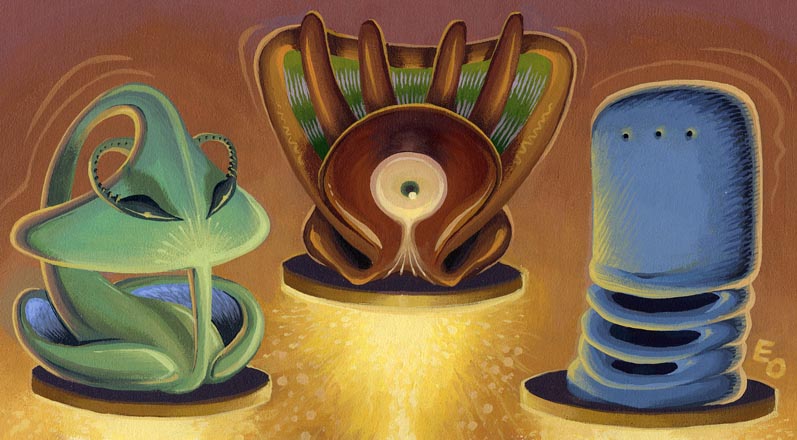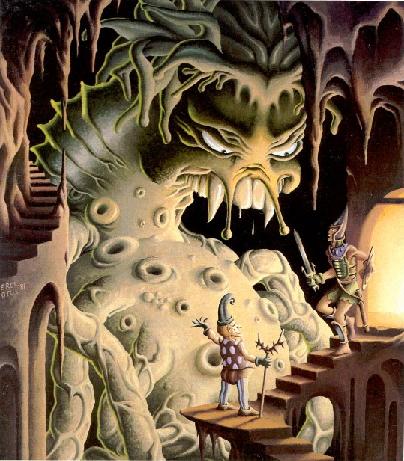I like to describe myself as a lifelong fan of the fantastic in the arts, but really, it all started for me in fourth grade.
My buddy Jason Thornton brought a new sort of game to school called Dungeons & Dragons. You didn’t need a board to play it, and with just a handful of funny-looking dice and a little imagination anyone could become a powerful wizard, master thief, swordsman or demon-smiting priest. It didn’t matter then that the only dwarves I knew hung around with Snow White, and that I preferred the kind of elves who lived in trees and baked cookies, or that I didn’t know J.R.R. Tolkien from H.R. Puffenstuff: being unfamiliar with fantasy tropes added to the feeling of exploration. I was hooked from game one and spent the rest of that year begging my parents for my own copy of the Dungeons & Dragons rules, which became my gateway into a new world of fantasy fiction, movies and more.
I loved everything about the game, but one of the very best parts was the artwork. The early stable of Dungeons & Dragons artists was great, but in my mind the very best of the bunch was Erol Otus. There was something psychedelic, witchy even, about his work that held my eye then and still does today. The men and monsters in his paintings weren’t quite fully representational. Something was different about them: they were cartoonish in a way that both delighted and threatened, like a child’s cartoon gone awry. Maybe it was the bright colors or the way that he depicted even the most terrible of creatures with their own personalities that suggests this description. Whatever it is that Otus did, it stayed with me for decades. To this day, nothing says “adventure” like an Erol Otus painting.
Dungeons & Dragons was only the beginning of a long and fruitful career for Otus. Since those days, he’s made a good living as a video game designer and freelance illustrator. I was recently able to spend a few minutes with the artist to discuss his career.
 What were you like as a child?
What were you like as a child?
Outgoing until about 4th grade, then I started to catch on and laid low until I got out of high school.
Were you always drawn to the visual arts?
Yes, constantly.
Can you recall the first time that you identified yourself as an artist?
[Age] six.
What was your first sale?
I first got paid doing illustrations for Dave Hargrave’s Arduin books. Before that I sold some original magic item card drawings and also got paid to paint some lead figurines, both of these for a local game shop.
Are you self-taught or did you have a formal education in art?
Self-taught, then after I left TSR [Tactical Studies Rules, Inc., original publisher of Dungeons & Dragons] I studied painting at UC Berkeley for a few years, and then illustration at the Academy of Art SF for another few.
I’ve always been attracted to your work because I always thought it seems to eschew a sense of strict “realism” in favor of a more symbolic or impressionistic aesthetic. Is this a fair description?
That is a fair observation, but I’m not thinking about realism versus anything. Just comes out this way. On the other hand it suits me fine and I don’t try to change it.
How would you best describe your art?
Things that are present in my mind when executing/planning art:
1. That the rules the piece itself brings into being are followed.
2. Entertain myself (the best way to entertain other viewers I think).
3. At least try to make something that would never otherwise have been made.
For me these all apply to both fine art painting and illustrations. Any creative activity really.
Is your singular “look” the result of a conscious evolution in certain directions, or is this just the way you’ve always drawn or painted?
It is unconscious. Or a result of rules and practices that were less about achieving a look and more about things behind the surface.
Tell me about your color palette. You seem to favor otherworldly, bright colors, noticeably contrasting them with dark backgrounds.
Sometimes colors are influenced by non-aesthetic factors. For example: If you were illustrating a medical textbook and felt that the chest cavity was too dominated by reds and browns and it needed some sky blue… too bad! These necessities can come from one’s own judgments as well.
Are there certain colors you find yourself returning to again and again?
Combinations, yes. Some of these arose from painting lead miniatures. I really like a pale blue fading into yellow-green, many others.
Would you mind discussing some of the artists, both classical and popular, who have influenced you?
Dr. Seuss: I’m talking about The 500 Hats of Bartholomew Cubbins, McElligot’s Pool, some images in The Sleep Book. Check out “Clark”… very powerful.
Bernie Wrightson: Master of Black and White.
Ugly Stickers (Basil Wolverton mainly): Many of these were made into rubber monsters (which I have in my collection).
Frank Frazetta: I would save up, buy his posters, put them on the wall and stare.
Kandinsky, de Kooning, Miro: These artists all worked with rules and rhythms that appeal to me very much.
Are there other things that have influenced you? Images in nature? The writings of certain authors? Music?
The patterns of chaos found in nature are very instructive. I’ve certainly read a lot, all kinds of books, but I’m hard-pressed to identify how this has influenced my drawing and painting. It certainly has influenced the way I write, though. Same with music. I’m sure these things have had some effect but I can’t figure it out.
You’re perhaps best known for your iconic work with the Dungeons & Dragons product line. Could you briefly recount how your came to be associated with TSR? What are your impressions of those days?
Well we were playing D & D a lot, and I was doing a great deal of fantasy illustration. I was sending artwork into TSR to be considered for publication. One the drawings was of a blue and fuchsia winged worm in an icy landscape, this was published in The Dragon #2 with stats by Gary Gygax as “The Remorhaz.” This was my first published color piece. I sent in several more things, including the write-up and artwork for “The Ankheg,” published in The Dragon #5. They ended up giving me a ring when looking to hire a staff artist and so I moved to Lake Geneva to work full time.
Blogger Jeff Rients has been a champion of your work for a long, long time, going so far as to erect a tribute page. Have you seen a resurgence of interest in your work as the first generations of Dungeons & Dragons players, like Jeff, enter into adulthood?
I’ve stayed in gaming, though for a long time it was only computer games, so I would run into fans and old friends now and then. But your question is on the money as over the last ten years there has been a growing resurgence. Definitely partly due to the demographics you suggest.
Do you have any collectors? Speaking of this, how might a private collector go about purchasing your work?
I very rarely sell originals. You see, TSR had a policy of keeping all originals created by their staff artists. When Wizards Of The Coast bought them they tried to return original artwork to what artists they could find. Unfortunately, it was discovered that most of my originals had been sold at auction or thrown away (it is said there was one art director who decided to “clean house”).
Have you taken any consignments or worked on any projects that might surprise those fans who best know you from your gaming artwork?
Probably not surprising but I’ve done a few record covers that are worth a peek. A couple for The Lord Weird Slough Feg and most recently one for End Of A Year.
What is it about working with games that you most enjoy?
The fusion of art and game design. Game design is a discipline that I’ve always been interested in.
Looking back on your career, what are you most proud of?
It is very gratifying to discover that many people like my work for the same reasons I do.
Is there anything you wish that you could change or do over?
Once you start thinking about things like this you’re finished!
Anything else you’d like to add?
Do you know about Star Control 2? It is a computer game I did some artwork for. It is an old but great game, play it!











Nice interview. His work – esp his black and white illustrations has a sense of whimsy and contrast to also puts me in mind of W. Heath Robinson – a brilliant illustrator.
Good work; Erol Otus’ artwork is both skilled in technique and imagination. The application of the surreal style to speculative fiction artworks is very successful. Certainly among my favourite artists in the genre and certainly deserving of being recognised a ‘great art’ as well.
I often wonder what it would have been like if Erol had been done the artwork for games like “Call of Cthulhu”. :)
EO rules!
Expedition to the Barrier Peaks/[i] was a good showcase for his work, too.[/i]
I often wonder what it would have been like if Erol had been done the artwork for games like “Call of Cthulhu”.
I assume you’ve seen the first printing of Deities and Demigods, in which EO did the artwork for the Cthulhu Mythos section? I loved his use of medieval background in those illustrations, with Yog Sothoth menacing fair young maidens and so forth.
Thanks for the interview. I’ve long been a fan of Otus’s artwork, although my enthusiasm was badly shaken after seeing Alma Mater. I would have loved to hear his opinion about that!
Erol Otus did the cover for the new edition of the HackMaster RPG titled HackMaster Basic and it is Great!
Cover Art here;
http://www.kenzerco.com/popup_image.php?pID=670&image=0
Great interview. Erol did the cover for our upcoming product, HackMaster Basic. You can view it here –
Thanks for a great interview, Matt.
Erol Otus, along with the rest of the early stable of TSR illustrators, defined the game for me. I loved his black and white character sketches.
Thanks for this interview. Honestly, when I think D&D, I think Erol Otus. His work has always been my favorite and I’ve kept hold of my original red & blue box sets primarily for the artwork within.
Erol, you rock!